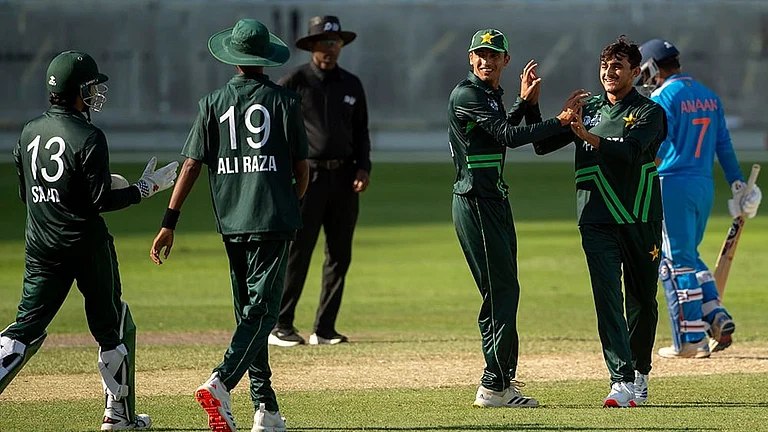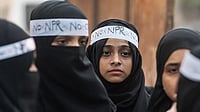The marigold flower garland adorning the framed photograph of Vijaymala Vijay Kadam kept in one corner of the tiny room next to the television set has dried. The yellow flowers are now darkish brown. About 10 days ago, Kadam died due to excessive bleeding and a reported botched-up hysterectomy surgery during childbirth. It was her 1.5-day-old child, a boy, who died first.
While his mother battled with life on the ground floor of the Shankarrao Chavan Government Medical College and Hospital, he was in an incubator on the first floor of the same hospital. Five days after his death, his mother lost the battle and died. She did not get to see the child she had given birth to.
The child’s death, along with the deaths of 31 others in the same government hospital in the span of 24 hours, made national headlines between September 30 and October 1. While a sizeable number of deaths on the first day was of newborns, the next four days saw 55 deaths, with 18 of them being newborns.
The dire shortage of medicines at the hospital has been cited as the primary reason for the deaths. The other reasons include the dearth of nurses, ward staff, and the negligent attitude of the hospital staff. The medical college attached to the hospital sends its doctors for on-job training to the wards of the hospital, say sources.
“The doctors are allowing these medical students to handle cases. Also, the doctors who have passed out of other medical colleges and have to do compulsory practice in rural hospitals are also there in the district hospitals. They are not bothered about the patients. The Nanded district hospital is filled with medical students and doctors from other parts of the country,” says a hospital source.
In Kakandi village, nearly 700 kms from Mumbai, Ananda Venkoba Bagal, the father of the deceased Vijaymala, sits in a room with walls painted in blue and green alternatively. There are some plastic flowers and hand-made crochet covers strewn around. He sits on a plastic chair, while his wife Kusum and their married daughter Savita Keshav Kadam occupy a single bed covered with colourful bedsheets. The produce from their fields is filled into gunny bags and stacked in corners of this room.

“Our daughter had a healthy pregnancy and walked to the hospital,” recollects Kusum with tears running down her cheeks. “Our daughter is gone. The doctors and nurses have killed our daughter and grandson,” she weeps inconsolably.
The room is filled with neighbours and relatives, each recounting Vijaymala’s life and the horror she went through at the hospital. Until some days before her due date, Vijaymala was being treated at a private hospital in Nanded city. This doctor had told the Bagals that Vijaymala would need a C-section childbirth.
Since the private hospital charged Rs 50,000-plus for a C-section, the Bagals took her to the Shankarrao Chavan Government Medical College and Hospital. Her older child, who is eight-years-old, was born at this government hospital through C-section. “We trusted this hospital. No doctor or nurse attended to her when we admitted her to the hospital in the evening. She was walking around in pain, pressing her stomach and back. She was taken to the operation theatre at 2.30 AM,” narrates Savita, the elder sister.
“From that evening until she was taken to the operation theatre, my sister was kept hungry. She was in the operation theatre for a long time. We kept asking about her, but no one answered our questions. An ayah told us that my sister was bleeding a lot and that the child was just kept aside. A nurse came and gave the baby covered in blood and dirt to us. She asked us to take the baby upstairs to the kaanch room (incubator). The nurses there refused to take the baby saying he was too dirty. They made us clean the baby before they admitted him there. He was sharing the incubator with three other babies,” says Savita.
Meanwhile, after several hours, a profusely bleeding Vijaymala was shifted to a bed in a ward. Since Savita was constantly present at the hospital, she says her sister’s condition worsened. In the interim, the baby had died. “The nurse was very rude to us. When I asked her why my sister was bleeding so much, she shouted at me telling me that she had not come to our house to bring my sister to the hospital. They kept taking signatures from me and anyone from our family who was there. After a day, when the heavy bleeding continued, they did a hysterectomy. She started bleeding more. She was put on a ventilator and she died,” narrates Savita.
The father says that the hospital did not give Vijaymala any medicines. He and his son were running around trying to organise cash to buy the medicines. “Some medicines were not available in the medical shop outside the hospital so we had to travel 15-20 kms to the city to buy the medicines. When we came back, the nurse would tell us that they needed some other medicine and we rushed out for that,” says Bagul, a farmer with a small-sized land holding.
“We were asked to get 14 bottles of blood and eight bottles of platelets. Though she was bleeding profusely, they kept giving her blood. The blood was coming out of her nose and ears,” weeps Savita.
The hospitalisation and the death of his daughter have left him with a debt of nearly a lakh, all borrowed from his relatives and others in the village. The hospital bills ran up to Rs 70,000.
The narrations include the rude and negligent behaviour of the hospital staff. “There were so many deaths in the hospital. The poor like us who come to the hospital are insulted at every turn. They are rude to us and treat us with contempt,” says Kusum.
According to Savita, in the days that Vijaymala was at the hospital, she had developed bed sores. “No one cleaned her and her body was bloody and dirty. My mother and I wiped the blood off her body. We needed three buckets of water to clean her up. We are treated badly because we are poor,” she says.
The rush of VIPs from every political party into Kakandi village has stopped. No one promised or gave any cash compensation. They came, sat, talked and went away, say the Bagals. Similar sentiments were echoed by the Kadams, the family Vijaymala is married into.
Half a kilometre away in the same village is Vijaymala’s marital home. Here too, her framed photograph is displayed in an inner room. Haldi-kumkum was applied on her photo frame, which is done when a married woman dies. There was no garland. The eight-year-old boy listens raptly to all the talk about his dead mother. He doesn’t cry. In fact, he has not cried at all, even during his mother’s funeral, say those gathered in the room in the Kadam household.
Shantabai Madhavrao Kadam, Vijaymala’s mother-in-law who is also her aunt, is angry at the hospital for the death of her daughter-in-law. “The nurse came and asked us if we wanted to take the body home or do a postmortem. We were shocked because they never told us that she had died,” recounts Shantabai.
The hospital, located in Vishnunagar, is a sprawling complex spread out over acres. There are people everywhere. Blue boards with white writing and arrows serve as a guide to the various buildings within the complex. There are pigs running around or feeding on the waste from the bins dotting the complex. A strong dirty stench greets the visitor upon entering the building. Paan and gutkha stains line every corner, including the stairways of all buildings. People are seated everywhere – on the floor, on the staircase and on the few chairs and benches lined against the paan-stained walls. The guards of the Maharashtra Suraksha Bal do not allow visitors to take tender coconuts inside. There are loud arguments for the cost of a single coconut is Rs 70, a very high cost for the poor who have patients admitted to the hospital.

Sources at the hospital say that the recent tragedy has not adversely impacted the number of patients coming to the hospital. Most of the relatives are gathered around the neo-natal, ICU and ICCU wards.
Nanded has two government hospitals – a smaller one sans the NICU facility at Shyamnagar and this one at Vishnunagar. People prefer the Shankarrao Chavan Government Hospital at Vishnunagar for it is bigger with more facilities. There is a dire shortage of nurses and cleaning staff at this hospital.
The mushrooming private hospitals speak volumes about the medical economy of Nanded. An increasing number of people like the Bagals and Kadams seek treatment at private hospitals despite the high medical costs. “When patients cannot be treated by private hospitals, they are sent to the government hospitals. Ninety-five per cent of the time these patients are in a very critical condition. Many of them die. How is a government hospital bad in such cases,” says a doctor of the Shankarrao Chavan Government Hospital.
Ward number 19, where Vijaymala was admitted and had died, bears no scars of that tragedy. There are two patients on a single cot, but it is “normal”, says an ayah who has been working at the hospital for several decades.
Hemant Patil, Shiv Sena MP from Hingoli, a neighbouring district of Nanded, made the hospital dean, Dr Shyamrao Wakode, clean the hospital’s toilets, which has now snowballed into a political controversy. While Wakode has filed a complaint against Patil under the Atrocities Act, the Sambhaji Brigade – a self-styled custodian of the interests of the Maratha community – has come out in support of Patil, lending a caste colour to the tragedy.
“My daughter is dead. I am seeped in debt. All the politicians do is make everything into a caste issue,” says Bagal.
The family of 21-year-old Anjali Waghmare, another victim of the hospital tragedy whose 1.5-day-old child died here, has filed a police complaint against the hospital.
Ten days after the deaths in the Nanded Hospital, Maharashtra Chief Minister Eknath Shinde unveiled Vision 2035 focusing on the public health system of the state under which all districts will get speciality hospitals. The government will also speed up recruitment to fill in the 19,695 vacant posts in the health department and has got Tata Consultancy Services (TCS) on board to do the needful. An officer of the Indian Administrative Service will be appointed to head the Maharashtra Medical Goods Procurement Authority, which was established in March this year. This procurement authority is yet to start work and the said appointment is to kick-start the working of this body. This has resulted in a shortage of medicines in government hospitals across Maharashtra, said sources.
The Nanded tragedy has put the government in action mode and it has now given permission to procure medicines at the local level. The procurement authority will be for single-point procurement and supply of certain medicines, medical goods, medical consumables, devices, equipment, etc. To manage the health concerns of the bludgeoning population, nine additional circles will be created to complement the existing eight circles of the health department.
About 13 district hospitals have closed down after they were linked to medical colleges. Another 12 district hospitals have been handed over to the medical education department. The state government will provide an additional Rs 1,263 crore to the existing Rs 8,331 crore of the supplementary budgetary demands for ambulances, construction of new hospital buildings and procurement of medical equipment.
Approval for Rs 3,948 crore from HUDCO has been granted which has to be utilised within a deadline. Additional funds of Rs 5,177 crore from the Asian Development Bank will be allocated for new medical institutions.


























